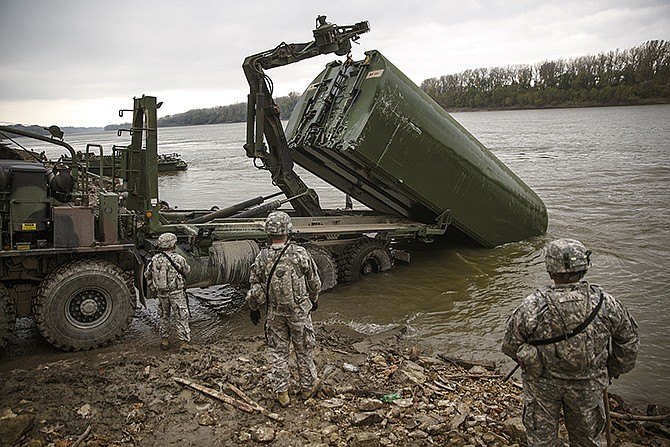Army soldiers wearing coyote brown, military-grade boots sunk their feet into mud along the Missouri River shore Wednesday as dozens of others built a 132-foot floating bridge on the flowing water.
Sgt. 1st Class Russell Bean stood on jagged rocks about 15 feet from the water line, wearing the same boots and camouflage uniform as his 50 fellow soldiers in the Fort Leonard Wood-based 50th Multi-Role Bridge Company. He overlooked boat operators pushing bridge pieces, or bays, toward a truck, docked on the river. Once connected, trucks transported bays onto land, one by one.
Gray clouds covered the sky, and muddy water flowed. A steady wind brushed against soldiers standing on floating bays in the mid-50s degree weather, waiting to be back on land.
Every six months, Bean said, the bridge company travels nearly two hours to the Ike Skelton Training Site in Jefferson City for mobile bridge training, which first platoon soldiers have been drilling since Monday. The second platoon will conduct the same training next week.
In the south-central region where Fort Leonard Wood is located, active duty soldiers only have still-water options for training, such as small lakes, ponds and creeks throughout the year. Their training on the Missouri River offered more real-life experience, with the river flowing at 9 feet per second.
Bean encountered faster-paced waters on the Tigris and Euphrates river system, between 15-20 feet per second, while serving multiple tours in Iraq.
"Instead of training on ponds and lakes all the time, we're training out here," Bean said, looking out on the Missouri River. "It teaches our bridge guys, especially our boat operators. ... They're learning being on faster water, so it makes them better operators. They're the key to the whole thing. If you've got good boat operators, the faster we can put it (the bridge) together."
The goal, he added, is to assemble the float bridge, with two ramp bays and four interior bays, in 20-25 minutes. They didn't stretch the bridge to the other side of the river during training, but would in an authentic scenario. Thick woods lined the far bank, offering no access point for trucks to drive.
"We raft military forces to get across the river, you know, to get to the other side to defeat the enemy," he said. "That's really what it's all about."
Boats entered the river first, then soldiers operating large trucks launch the bays, which folded, into the water. Once the bay hit the river, it unfolded into a flat piece. Boat operators, like Spec. Shaquille Head, connected the MK2 boats with the bays through the boats' push knee fenders and guided the bays together to form the floating bridge. They are sometimes fighting the current.
Head called his role a "top-notch" job due to its high-risk aspects. Boat operators must control steering and speed as soldiers work to bring together bays and other pieces of heavy machinery.
"The smallest mistake you make could end someone's life, so it's all about safety," he said. "That's why my job is so important."
On land, Spec. Justin Scarborough and other soldiers prepared the trucks to properly place the bays into the river, "without breaking anything or anybody," he said. The process isn't complicated, Scarborough added, but the smallest mistake could damage expensive equipment. Before a truck heads to the shore, Scarborough checks that the truck is an 8-by-8, the latches open and the wench is unhooked, among other actions.
Standing next to roaring engines, the 20-year-old soldier said the training experience has been invaluable.
"It's all we can do," Scarborough said. "If we don't get training like this, then we kind of don't know our jobs. The only way we can know our job is to get out there and do it."

